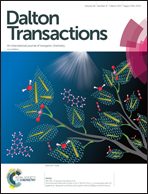Infrared spectroscopic study of absorption and separation of CO using copper(i)-containing ionic liquids†
Abstract
Absorption of carbon monoxide by copper(I)-containing ionic liquids, [Cnmim][CuX2] (Cnmim = 1-alkyl-3-methylimidazolium, n = 2, 4, 6, X = Cl, Br, I) has been investigated using in situ high pressure infrared spectroscopy. For each liquid, observation of a ν(CO) band in the region 2075–2090 cm−1 indicates the formation of copper(I) monocarbonyl complexes, assigned as [Cu(CO)X2]−. The rate of growth and equilibrium intensity of the ν(CO) absorption is dependent on applied CO pressure. Binding of CO is reversible such that complete desorption occurs rapidly on heating above 100 °C and the liquids are robust over multiple gas absorption/desorption cycles. For the series of [C6mim][CuX2] salts the CO absorption ability follows the order Cl ≥ Br ≫ I. Selective absorption of CO from CO/H2 and CO/N2 gas mixtures is demonstrated by measuring the changes in headspace CO content upon absorption and desorption of gas. For [C6mim][CuCl2], a single absorb–vent–desorb cycle yields product gas containing ∼95% CO starting from a 1 : 1 CO/N2 mixture, increasing to ∼98% CO starting from a 4 : 1 CO/N2 mixture. This is particularly promising in view of the similar boiling points of CO and N2 that hinders their separation by cryogenic distillation.



 Please wait while we load your content...
Please wait while we load your content...